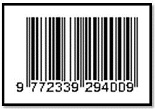Exploring Slang Words on Social Media TikTok in 2024
Abstract
Keywords
Full Text:
PDFReferences
M. Tomenchuk and T. Tiushka, “The Impact Of Tiktok On English Language: Slang And Trends,” vol. 11, no. 42, pp. 441–447, 2024.
E. G. Thorvik, “Is TikTok a New Way to Support Language Learning ?,” no. May, 2023.
K. Matsumoto, F. Ren, M. Matsuoka, M. Yoshida, and K. Kita, “Slang feature extraction by analysing topic change on social media,” vol. 4, pp. 64–71, 2019, doi: 10.1049/trit.2018.1060.
Oberlo, “TikTok Growth Rate (2019–2029) [Jul 2024 Update],” 2024. https://www.oberlo.com/statistics/tiktok-growth-rate
G. Yule, “The Study of Language, Cambridge University Press,” NY USA, 2006.
J. Coleman, The Life of Slang. Oxford University Press, 2012.
W. Trimastuti, “An Analysis Of Slang Words Used In Social Media,” vol. 5, no. 2, pp. 64–68, 2017.
T. I. Rezeki, R. W. Sagala, E. Panjaitan, and I. Introduction, “Slang words used by millennial generation in instagram 1,” vol. 11, no. 2, 2019.
P. Trudgill, Sociolinguistic typology: Social determinants of linguistic complexity. Oxford University Press, 2011.
J. K. Chambers, “Sociolinguistic theory: Linguistic variation and its social significance,” (No Title), 1995.
A. Yusuff, a. O. Sanni, and s. Kareem, “Communicative and Language Patterns in Popular Slangs in Nigeria,” J. Commun. Pedagog. Pract., vol. 1, no. 1, 2024.
R. A. Spears, NTC’s dictionary of American slang and colloquial expressions. NTC Pub. Group, 2000.
L. A. Onebunne and O. S. Akujobi, “The communicative relevance of slang among undergraduates of Nnamdi Azikiwe University, Awka,” Interdiscip. J. African Asian Stud., vol. 7, no. 2, 2021.
K. Allan and K. Burridge, Forbidden words: Taboo and the censoring of language. Cambridge University Press, 2006.
N. K. Padilah, “The Use of Slang Words on Social Media TikTok in 2022,” 2022.
G. N. Leech, Towards a semantic description of English. Indiana University Press, Bloomington, Indiana 47401, 1970.
Selviana, “An Analysis Of Slang Words Used In ‘Toy Story 4’ Movie Script,” Islamic University Raden Intan Lampung, 2021.
E. D. Saputri, “The use of Slang words on the captions of Kim Kardashian’s instagram account,” UIN Sunan Gunung Djati Bandung, 2021.
J. W. Creswell and J. D. Creswell, Research design: Qualitative, quantitative, and mixed methods approaches. Sage publications, 2017.
R. Gallagher and R. Topinka, “The politics of the NPC meme: Reactionary subcultural practice and vernacular theory,” Big Data Soc., vol. 10, no. 1, p. 20539517231172424, 2023.
M. A. Al Wafa, T. S. Darungan, S. Akbar, and Z. Damanik, “The relationship of doomscrolling with anxiety in students of the Faculty of Medicine, Islamic University of North Sumatra,” Asian J. Heal. Sci., vol. 3, no. 7, pp. 188–196, 2024.
M. Z. Barabak, “Doomscrolling.” Here’s how the coronavirus is changing the way we talk. Los Angeles Times,” Quarantini, 2020.
J. Mercer and C. Smith, “‘Thirst Trapping’: Digitised Desire and the Online Sexual Economy,” in Sexualised Masculinity, Routledge, 2025, pp. 202–228.
On Par Therapy, “What Is Rage Baiting? The Manipulation Tactic That’s Hijacking Your Emotions (And How to Stop It),” 2024. https://www.onpartherapynyc.com/blog/rage-baiting-meaning (accessed Jun. 27, 2025).
K. van Beek, “Keyboard warriors: Writing as a tool for positive change. Practitioner thesis,” 2023.
Dictionary.com, “Throwing shade Meaning & Origin | Slang by Dictionary.com,” 2018. https://www.dictionary.com/e/slang/throwing-shade/?utm_source (accessed Jun. 27, 2025).
Jack Reid, “Root Source: Spilling the Tea,” USC Annenberg Media, 2021. https://www.uscannenbergmedia.com/2021/09/21/root-source-spilling-the-tea/?utm_source
Liam Daniel, “‘No Cap’ Meaning, Origin and Examples,” 7ESL, 2025. https://7esl.com/no-cap-meaning/?utm_source
R. Dylewski, “Smitherman, Geneva. 2006. Word from the mother: Language and African Americans. New York: Routledge. xiii+ 172 pages. ISBN: 0-415-35876.,” 2007.
Isabella Claire, “IYKYK Meaning, Origin and Examples,” 7ESL, 2024. https://7esl.com/iykyk-meaning/
H. Bird, “A Merriam-Webster editor explained Tom Brady’s role in ‘GOAT’ entering the dictionary,” Boston.com, 2018. https://www.boston.com/sports/new-england-patriots/2018/09/07/tom-brady-goat-dictionary/
Gaurav Rathore, “GRWM Meaning: Its Origin, Uses, and Safety Concerns for Kids,” 2025. https://radarro.com/grwm-meaning/
Isabella Claire, “NGL Meaning, Origin and Usage,” 7ESL, 2024. https://7esl.com/ngl/
Danny Paez, “Everyone’s favorite Among Us catchphrase has a controversial past,” 2024. https://www.inverse.com/gaming/sus-meaning-among-us-definition-origin
English Study Online, “Fam Meaning: What Does Fam Mean?,” 2025. https://englishstudyonline.org/fam-meaning/
B. L. Elvira, R. Firdaus, and A. Setijowati, “The Influence of POV Trend as a Branding Image Content Creator on TikTok,” Int. J. Innov. Sci. Res. Technol., vol. 8, no. 9, 2023.
Merriam-Webster, “How to Use legit in a Sentence,” 2022. https://www.merriam-webster.com/sentences/legit
G. McCulloch, Because internet: Understanding the new rules of language. Penguin, 2020.
E. Chapel, “Slang and Sociability: In-Group Language among College Students. By Connie,” J. English Linguist., vol. 26, no. 3, pp. 247–265, 1998.
Iis Kurnia Nurhayati and Aliyya Rahma Putri, “Exploring Cyberculture : A Virtual Ethnographic Perspective on Generation Z Slang on TikTok,” J. Sosioteknologi Inst. Teknol. Bandung, vol. 23, no. 3, pp. 400–415, 2024.
A. A. Atuzzahro, D. T. Handatika, and A. R. Puspita, “Penggunaan Bahasa Gaul dalam Komunikasi Digital pada Konten Tiktok Nathalie Tresya,” Blaz. J. Bhs. dan Sastra dalam Pendidik. Linguist. dan Pengemb., vol. 3, no. 2, pp. 169–178, 2025.
B. Rime, B. Mesquita, S. Boca, and P. Philippot, “Beyond the emotional event: Six studies on the social sharing of emotion,” Cogn. Emot., vol. 5, no. 5–6, pp. 435–465, 1991.
F. Angelini, C. Marino, and G. Gini, “Friendship quality in adolescence: the role of social media features, online social support and e-motions,” Curr. Psychol., vol. 42, no. 30, pp. 26016–26032, 2023.
DOI: https://doi.org/10.31764/leltj.v13i1.31704
Refbacks
- There are currently no refbacks.
Copyright (c) 2025 Anissa Ikhsan Jose

This work is licensed under a Creative Commons Attribution-ShareAlike 4.0 International License.
_____________________________________________________
Linguistics and ELT Journal
p-ISSN 2339-2940 | e-ISSN 2614-8633

LELTJ is licensed under a Creative Commons Attribution-ShareAlike 4.0 International License.
_____________________________________________________
LELTJ is abstracting & indexing in the following databases:
_____________________________________________________
LELTJ Editorial Office:













